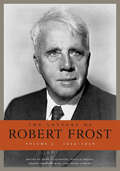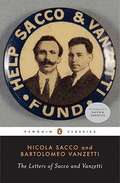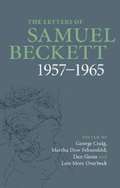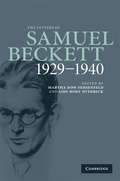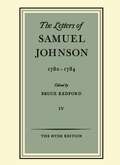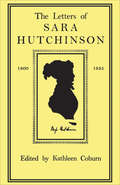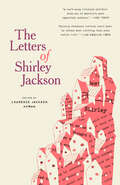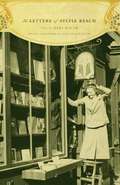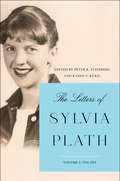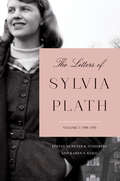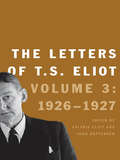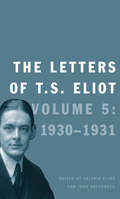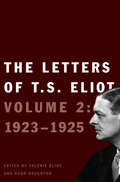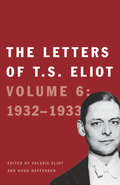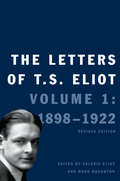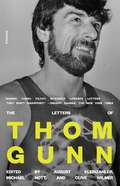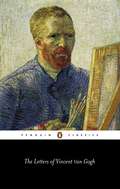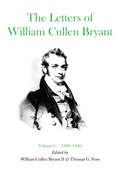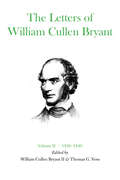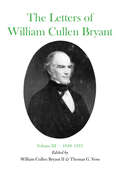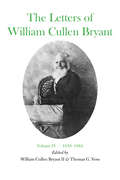- Table View
- List View
The Letters of Robert Frost, Volume 2
by Robert FrostThe second installment of Harvard's critically acclaimed five-volume edition of Robert Frost's correspondence contains letters from 1920 to 1928, 400 of them gathered here for the first time. His 160 correspondents include family, friends, colleagues, fellow writers, visual artists, publishers, educators, librarians, farmers, and admirers.
The Letters of Robert Frost, Volume 3: 1929-1936
by Robert FrostThe third installment of Harvard’s five-volume edition of Robert Frost’s correspondence. The Letters of Robert Frost, Volume 3: 1929–1936 is the latest installment in Harvard’s five-volume edition of the poet’s correspondence. It presents 589 letters, of which 424 are previously uncollected. The critically acclaimed first volume, a Times Literary Supplement Book of the Year, included nearly 300 previously uncollected letters, and the second volume 350 more. During the period covered here, Robert Frost was close to the height of his powers. If Volume 2 covered the making of Frost as America’s poet, in Volume 3 he is definitively made. These were also, however, years of personal tribulation. The once-tight Frost family broke up as marriage, illness, and work scattered the children across the country. In the case of Frost’s son Carol, both distance and proximity put strains on an already fractious relationship. But the tragedy and emotional crux of this volume is the death, in Montana, of Frost’s youngest daughter, Marjorie. Frost’s correspondence from those dark days is a powerful testament to the difficulty of honoring the responsibilities of a poet’s eminence while coping with the intensity of a parent’s grief. Volume 3 also sees Frost responding to the crisis of the Great Depression, the onset of the New Deal, and the emergence of totalitarian regimes in Europe, with wit, canny political intelligence, and no little acerbity. All the while, his star continues to rise: he wins a Pulitzer for Collected Poems in 1931 and will win a second for A Further Range, published in 1936, and he is in constant demand as a public speaker at colleges, writers’ workshops, symposia, and dinners. Frost was not just a poet but a poet-teacher; as such, he was instrumental in defining the public functions of poetry in the twentieth century. In the 1930s, Frost lived a life of paradox, as personal tragedy and the tumults of politics interwove with his unprecedented achievements. Thoroughly annotated and accompanied by a biographical glossary and detailed chronology, these letters illuminate a triumphant and difficult period in the life of a towering literary figure.
The Letters of Sacco and Vanzetti
by Nicola Sacco Bartolomeo VanzettiCommemorating the eightieth anniversary of Sacco and Vanzetti's execution- with a new cover and new foreword Electrocuted in 1927 for the murder of two guards in Massachusetts, the Italian- American anarchists Nicola Sacco and Bartolomeo Vanzetti defied the verdict against them, maintaining their innocence to the end. Whether they were guilty continues to be the subject of debate today. First published in 1928, Sacco and Vanzetti's letters represent one of the great personal documents of the twentieth century: a volume of primary source material as famous for the splendor of its impassioned prose as for the brilliant light it sheds on the characters of the two dedicated anarchists who became the focus of worldwide attention. .
The Letters of Samuel Beckett 1957-1965 Volume 3
by Samuel Beckett Martha Dow Fehsenfeld Lois More Overbeck George Craig Dan GunnThis third volume of The Letters of Samuel Beckett focuses on the years when Beckett is striving to find a balance between the demands put upon him by his growing international fame, and his need for the peace and silence from which new writing might emerge. This is the period in which Beckett launches into work for radio, film and, later, into television. It also marks his return to writing fiction, with his first major piece for a decade, Comment c'est (How It Is). Where hitherto he has been reticent about the writing process, now he devotes letter after letter to describing and explaining his work in progress. For the first time Beckett has a woman as his major correspondent: a relationship shown in his intense and abundant letters to Barbara Bray. The volume also provides critical introductions, chronologies, explanatory notes and profiles of Beckett's main correspondents.
The Letters of Samuel Beckett, 1929-1940
by Samuel Beckett Martha Dow Fehsenfeld Lois More Overbeck George Craig Daniel Gunn Dan GunnThe letters written by Samuel Beckett between 1929 and 1940 provide a vivid and personal view of Western Europe in the 1930s, and mark the gradual emergence of Beckett's unique voice and sensibility. The Cambridge University Press edition of The Letters of Samuel Beckett offers for the first time a comprehensive range of letters of one of the greatest literary figures of the twentieth century. Selected for their bearing on his work from over 15,000 extant letters, the letters published in this four-volume edition encompass sixty years of Beckett's writing life (1929-1989), and include letters to friends, painters and musicians, as well as to students, publishers, translators, and colleagues in the world of literature and theatre. For anyone interested in twentieth-century literature and theatre this edition is essential reading, offering not only a record of Beckett's achievements but a powerful literary experience in itself.
The Letters of Samuel Johnson 1782-1784 (The Hyde Edition #Vol. IV)
by Samuel JohnsonThis epistolary endgame includes the breakup of the friendship with Hester Thrale, medical dramas of every description, and a poignant reaching out to new friends and new experiences. The letters of 1782-84 exemplify in abundance what Johnson himself praises and provides, 'the interchange of that social officiousness by which we are habitually endeared to one another.
The Letters of Sara Hutchinson
by Kathleen Coburn Sara HutchinsonSarah Hutchinson has never been much more than a name, though a name connected with some of the greatest in English literature. The sister of Mrs. Wordsworth, and a member of the Wordsworth household for thirty years, Coleridge's beloved Asra to whom many of his poems were written, Southey's friend and Lamb's, and a guest of the Arnolds at Rugby, she was a member of an interesting circle. For her intimate relations to Wordsworth and Coleridge it has long been apparent that we should like to know her better. Now her letters to members of her family and to friends demonstrate how worthwhile it is to know her for herself as well.<P><P>The letters come from the family and from the Wordsworth collection at Dove Cottage and are here printed (almost in full) for the first time.<P>They show a lively and amusing woman, kind, forthright to the extent of bluntness, especially when she takes up the cudgels in the cause of what she considers truth or justice or human kindness. Coleridge describes her in one apt and characteristic sentence: <P>'If Sense, Sensibility, Sweetness of Temper, perfect simplicity and unpretending Nature, joined to shrewdness and entertainingness make a valuable Woman, Sara Hutchinson is so.'<P>Such qualities certainly make a delightful letter-writer.
The Letters of Seamus Heaney
by Seamus HeaneyThe letters provide us with an intimate, multilayered understanding of this extraordinary poet’s life and mind.Every now and again I need to get down here, to get into the Diogenes tub, as it were, or the Colmcille beehive hut, or the Mossbawn scullery. At any rate, a hedge surrounds me, the blackbird calls, the soul settles for an hour or two.In this astute selection from Seamus Heaney’s vast correspondence, we are given direct access to the life and poetic development of a literary titan, from his early days in Belfast, through his controversial decision to settle in the Republic, to the gradual broadening of horizons that culminated in the award of the Nobel Prize in Literature and the years of international eminence that kept him heroically busy until his death.Christopher Reid draws from both public and private archives to reveal this remarkable story in the poet’s own words. Generous, funny, exuberant, confiding, irreverent, empathetic, and deeply thoughtful, The Letters of Seamus Heaney encompasses decades-long relationships with friends and colleagues, as well as an unstinted responsiveness to passing acquaintances.Heaney’s mastery of language is as evident here as it is in any of his writings; listening to his voice we find ourselves in the same room as a man whose presence enriched the world and whose legacy deepens our sense of what truly matters.
The Letters of Shirley Jackson
by Shirley JacksonA bewitchingly brilliant collection of never-before-published letters from the renowned author of &“The Lottery&” and The Haunting of Hill House&“This biography-through-letters gives an intimate and warm voice to the imagination behind the treasury of uncanny tales that is Shirley Jackson&’s legacy.&”—Joyce Carol OatesShirley Jackson is one of the most important American authors of the last hundred years and among our greatest chroniclers of the female experience. This extraordinary compilation of personal correspondence has all the hallmarks of Jackson&’s beloved fiction: flashes of the uncanny in the domestic, sparks of horror in the quotidian, and the veins of humor that run through good times and bad.i am having a fine time doing a novel with my left hand and a long story—with as many levels as grand central station—with my right hand, stirring chocolate pudding with a spoon held in my teeth, and tuning the television with both feet.Written over the course of nearly three decades, from Jackson&’s college years to six days before her early death at the age of forty-eight, these letters become the autobiography Shirley Jackson never wrote. As well as being a bestselling author, Jackson spent much of her adult life as a mother of four in Vermont, and the landscape here is often the everyday: raucous holidays and trips to the dentist, overdue taxes and frayed lines of Christmas lights, new dogs and new babies. But in recounting these events to family, friends, and colleagues, she turns them into remarkable stories: entertaining, revealing, and wise. At the same time, many of these letters provide fresh insight into the genesis and progress of Jackson&’s writing over nearly three decades.The novel is getting sadder. It&’s always such a strange feeling—I know something&’s going to happen, and those poor people in the book don&’t; they just go blithely on their ways.Compiled and edited by her elder son, Laurence Jackson Hyman, in consultation with Jackson scholar Bernice M. Murphy and featuring Jackson&’s own witty line drawings, this intimate collection holds the beguiling prism of Shirley Jackson—writer and reader, mother and daughter, neighbor and wife—up to the light.
The Letters of Sylvia Beach
by Sylvia Beach Keri Walsh No?l Riley FitchFounder of the Left Bank bookstore Shakespeare and Company and the first publisher of James Joyce's Ulysses, Sylvia Beach had a legendary facility for nurturing literary talent. In this first collection of her letters, we witness Beach's day-to-day dealings as bookseller and publisher to expatriate Paris. Friends and clients include Ernest Hemingway, Gertrude Stein, H. D. , Ezra Pound, Janet Flanner, William Carlos Williams, F. Scott Fitzgerald, James Joyce, and Richard Wright. As librarian, publicist, publisher, and translator, Beach carved out a unique space for herself in English and French letters. This collection reveals Beach's charm and resourcefulness, sharing her negotiations with Marianne Moore to place Joyce's work in The Dial; her battle to curb the piracy of Ulyssesin the United States; her struggle to keep Shakespeare and Company afloat during the Depression; and her complicated affair with the French bookstore owner Adrienne Monnier. These letters also recount Beach's childhood in New Jersey; her work in Serbia with the American Red Cross; her internment in a German prison c& and her friendship with a new generation of expatriates in the 1950s and 1960s. Beach was the consummate American in Paris and a tireless champion of the avant-garde. Her warmth and wit made the Rue de l'Od on the heart of modernist Paris.
The Letters of Sylvia Beach
by Sylvia BeachFounder of the Left Bank bookstore Shakespeare and Company and the first publisher of James Joyce's Ulysses, Sylvia Beach had a legendary facility for nurturing literary talent. In this first collection of her letters, we witness Beach's day-to-day dealings as bookseller and publisher to expatriate Paris. Friends and clients include Ernest Hemingway, Gertrude Stein, H. D., Ezra Pound, Janet Flanner, William Carlos Williams, F. Scott Fitzgerald, James Joyce, and Richard Wright. As librarian, publicist, publisher, and translator, Beach carved out a unique space for herself in English and French letters. This collection reveals Beach's charm and resourcefulness, sharing her negotiations with Marianne Moore to place Joyce's work in The Dial; her battle to curb the piracy of Ulysses in the United States; her struggle to keep Shakespeare and Company afloat during the Depression; and her complicated affair with the French bookstore owner Adrienne Monnier. These letters also recount Beach's childhood in New Jersey; her work in Serbia with the American Red Cross; her internment in a German prison camp; and her friendship with a new generation of expatriates in the 1950s and 1960s. Beach was the consummate American in Paris and a tireless champion of the avant-garde. Her warmth and wit made the Rue de l'Odéon the heart of modernist Paris.
The Letters of Sylvia Plath Vol 2: 1956-1963
by Sylvia Plath"A scintillating and poignant autobiography in letters. . . . Her letters blaze with fresh and stunning revelations, with more to come."—Booklist on The Letters of Sylvia Plath Vol 1The second volume in the definitive, complete collection of the letters of Pulitzer Prize-winning poet, Sylvia Plath, from the early years of her marriage to Ted Hughes to the final days leading to her suicide in 1963, many never before seen.One of the most talented and beloved poets, Sylvia Plath continues to fascinate and inspire the modern literary imagination. The tragedy of her untimely death at age thirty, almost fifty-five years ago, has left much unknown about her creative and personal life. In this remarkable second volume of the iconic poet and writer’s collected letters, the full range of Plath’s ambitions, talents, fears, and perspective is made visible through her own powerful words.As engaging as they are revealing, these remarkable letters cover the years from 1957 to 1963. They detail the last six tumultuous and prolific years of her life, covering her marriage to Ted Hughes, the births of her children Frieda and Nicholas, her early success, including the publication of the classic The Bell Jar, and her ongoing struggle with depression.The first compendium of its kind to include all of Plath’s letters from this period, The Letters of Sylvia Plath Volume 2 offers an intimate portrait of the writing life and mind of one of the most celebrated poets in literary history.
The Letters of Sylvia Plath Volume 1: 1940-1956
by Sylvia PlathA major literary event: the first volume in the definitive, complete collection of the letters of Sylvia Plath—most never before seen.One of the most beloved poets of the modern age, Sylvia Plath continues to inspire and fascinate the literary world. While her renown as one of the twentieth century’s most influential poets is beyond dispute, Plath was also one of its most captivating correspondents. The Letters of Sylvia Plath is the breathtaking compendium of this prolific writer’s correspondence with more than 120 people, including family, friends, contemporaries, and colleagues. The Letters of Sylvia Plath includes her correspondence from her years at Smith, her summer editorial internship in New York City, her time at Cambridge, her experiences touring Europe, and the early days of her marriage to Ted Hughes in 1956.Most of the letters are previously unseen, including sixteen letters written by Plath to Hughes when they were apart after their honeymoon. This magnificent compendium also includes twenty-seven of Plath’s own elegant line drawings taken from the letters she sent to her friends and family, as well as twenty-two previously unpublished photographs. This remarkable, collected edition of Plath’s letters is a work of immense scholarship and care, presenting a comprehensive and historically accurate text of the known and extant letters that she wrote. Intimate and revealing, this masterful compilation offers fans and scholars generous and unprecedented insight into the life of one of our most significant poets.
The Letters of T. S. Eliot
by Valerie Eliot John HaffendenIn the period covered by this richly detailed collection, which brings the poet to the age of forty, T. S. Eliot was to set a new course for his life and work. Forsaking the Unitarianism of his American forebears, he was received into the Church of England and naturalised as a British citizen - a radical and public alteration of the intellectual and spiritual direction of his career. The demands of Eliot's professional life as writer and editor became more complex and exacting during these years. The celebrated but financially-pressed periodical he had been editing since 1922 - The Criterion - switched between being a quarterly and a monthly, before being rescued by the fledgling house of Faber & Gwyer. In addition to writing numerous essays and editorials, lectures, reviews, introductions and prefaces, his letters show Eliot involving himself wholeheartedly in the business of his new career as a publisher. His Ariel poems, Journey of the Magi (1927) and A Song for Simeon (1928) established a new manner and vision for the poet of The Waste Land and 'The Hollow Men'. These are also the years in which Eliot published two sections of an exhilaratingly funny, savage, jazz-influenced play-in-verse - 'Fragment of a Prologue' and 'Fragment of an Agon' - which were subsequently brought together as Sweeney Agonistes. In addition, he struggled to translate the remarkable work Anabase, by St. -John Perse, which was to be a signal influence upon his own later poetry. This correspondence with friends and mentors vividly documents all the stages of Eliot's personal and artistic transformation during these crucial years, the continuing anxieties of his private life, and the forging of his public reputation.
The Letters of T. S. Eliot
by T. S. EliotThis fifth volume of the collected letters of poet, playwright, essayist, and literary critic Thomas Stearns Eliot covers the years 1930 through 1931. It was during this period that the acclaimed American-born writer earnestly embraced his newly avowed Anglo-Catholic faith, a decision that earned him the antagonism of friends like Virginia Woolf and Herbert Read. Also evidenced in these correspondences is Eliot's growing estrangement from his wife Vivien, with the writer's newfound dedication to the Anglican Church exacerbating the unhappiness of an already tormented union. Yet despite his personal trials, this period was one of great literary activity for Eliot. In 1930 he composed the poems Ash-Wednesday and Marina, and published Coriolan and a translation of Saint-John Perse's Anabase the following year. As director at the British publishing house Faber & Faber and editor of The Criterion, he encouraged W. H. Auden, Stephen Spender, Louis MacNeice, and Ralph Hogdson, published James Joyce's Haveth Childers Everywhere, and turned down a book proposal from Eric Blair, better known by his pen name, George Orwell. Through Eliot's correspondences from this time the reader gets a full-bodied view of a great artist at a personal, professional, and spiritual crossroads.
The Letters of T. S. Eliot Volume 2
by John HaffendenVolume Two: 1923–1925 covers the early years of Eliot's editorship of The Criterion, publication of The Hollow Men, and his developing thought about poetry and poetics. The volume offers 1,400 letters, charting Eliot's journey toward conversion to the Anglican faith, as well as his transformation from banker to publisher and his appointment as director of the new publishing house Faber & Gwyer. The prolific and various correspondence in this volume testifies to Eliot's growing influence as cultural commentator and editor.
The Letters of T. S. Eliot: 19321933
by T. S. Eliot Valerie Eliot John HaffendenThe letters between Eliot and his associates, family and friends - his correspondents range from the Archbishop of York and the American philosopher Paul Elmer More to the writers Virginia Woolf, Herbert Read and Ralph Hodgson - serve to illuminate the ways in which his Anglo-Catholic convictions could, at times, prove a self-chastising and even alienating force. 'Anyone who has been moving among intellectual circles and comes to the Church, may experience an odd and rather exhilarating feeling of isolation,' he remarks. Notwithstanding, he becomes fully involved in doctrinal controversy: he espouses the Church as an arena of discipline and order. Eliot's relationship with his wife, Vivien, continues to be turbulent, and at times desperate, as her mental health deteriorates and the communication between husband and wife threatens, at the coming end of the year, to break down completely. At the close of this volume Eliot will accept a visiting professorship at Harvard University, which will take him away from England and Vivien for the academic year 1932-33.
The Letters of T.S. Eliot Volume 1
by Valerie Eliot Hugh HaughtonVolume One of the Letters of T.S. Eliot, edited by Valerie Eliot in 1988, covered the period from Eliot's childhood in St Louis, Missouri, to the end of 1922, by which time he had settled in England, married and published The Waste Land. Since 1988, Valerie Eliot has continued to gather materials from collections, libraries and private sources in Britain and America, towards the preparation of subsequent volumes of the Letters edition. Among new letters to have come to light, a good many date from the years 1898-1922, which has necessitated a revised edition of Volume One, taking account of approximately two hundred newly discovered items of correspondence. The new letters fill crucial gaps in the record, notably enlarging our understanding of the genesis and publication of The Waste Land. Valuable, too, are letters from the earlier and less documented part of Eliot's life, which have been supplemented by additional correspondence from family members in America.
The Letters of Thom Gunn
by Thom GunnThe Letters of Thom Gunn presents the first complete portrait of the private life, reflections, and relationships of a maverick figure in the history of British and American poetry. “I write about love, I write about friendship,” remarked Thom Gunn. “I find that they are absolutely intertwined.” These core values permeate his correspondence with friends, family, lovers, and fellow poets, and they shed new light on “one of the most singular and compelling poets in English during the past half-century” (Hugh Haughton, The Times Literary Supplement). The Letters of Thom Gunn, edited by August Kleinzahler, Michael Nott, and Clive Wilmer, reveals the evolution of Gunn’s work and illuminates the fascinating life that informed his poems: his struggle to come to terms with his mother’s suicide; settling in San Francisco and his complex relationship with England; his changing relationship with his life partner, Mike Kitay; the LSD trips that led to his celebrated collection Moly (1971); and the deaths of friends from AIDS that inspired the powerful, unsparing elegies of The Man with Night Sweats (1992).
The Letters of Vincent Van Gogh
by Vincent Van GoghA new selection of Vincent Van Gough's letters, based on an entirely new translation, revealing his religious struggles, his fascination with the French Revolution, his search for love and his involvement in humanitarian causes.
The Letters of William Cullen Bryant: Volume I, 1809–1836
by William Cullen BryantThis is the only collection ever made of Bryant's letters, two-thirds of which have never before been printed. Their publication was foreseen by the late Allan Nevin as "one of the most important and stimulating enterprises contributory to the enrichment of the nation's cultural and political life that is now within range of individual and group effort.William Cullen Bryant (1794–1878) was America's earliest national poet. His immediate followers—Longfellow, Poe, and Whitman—unquestionably began their distinguished careers in imitation of his verses. But Bryant was even more influential in his long career as a political journalist, and in his encouragement of American art, from his lectures at the National Academy of Design in 1828 to his evocation of the Metropolitan Museum of Art in 1870. Between the appearance of his first major poem, "Thanatopsis," in 1817, and his death sixty-one years later at the age of eight-three, Bryant knew and corresponded with an extraordinary number of eminent men and women. More than 2,100 of his know letters have already been recovered for the present edition.When William Cullen Bryant signed the first of 314 letters in the present volume, in 1809, he was a frail and shy farm boy of fourteen who had nonetheless already won some fame as the satirist of Thomas Jefferson. When he wrote the last, in 1836, he had become the chief poet of his country, the editor of its principal liberal newspaper, and the friend and collaborator of its leading artists and writers. His collected poems, previously published at New York, Boston, and London, were going into their third edition. His incisive editorials in the New York Evening Post were affecting the decisions of Andrew Jackson's administration. His poetic themes were beginning to find expression in the landscape paintings of Robert Weir, Asher Durand, and Thomas Cole.The early letters gathered here in chronological order give a unique picture of Cullen Bryant's youth and young manhood: his discipline in the classics preparatory to an all-too-brief college tenure; his legal study and subsequent law practice; the experiments with romantic versification which culminated in his poetic masterpieces, and those with the opposite sex which led to his courtship and marriage; his eager interest in the politics of the Madison and Monroe Presidencies, and his subsequent activities as a local politician and polemicist in western Massachusetts; his apprenticeship as magazine editor and literary critic in New York City, from which his later eminence as journalist was the natural evolution; the lectures on poetry and mythology which foreshadowed a long career as occasional orator; the collaboration in writing The Talisman, The American Landscape, and Tales of Glauber-Spa, and in forming the National Academy of Design, and the Sketch Club, which brought him intimacy with writers, artists, and publishers; his first trip to the Aemrican West, and his first long visit to Europe, during which he began the practice of writing letters to his newspaper which, throughout nearly half a century, proved him a perceptive interpreter of the distant scene to his contemporaries.Here, in essence, is the first volume of the autobiography of one whom Abraham Lincoln remarked after his first visit to New York City in 1860, "It was worth the journey to the East merely to see such a man." And John Bigelow, who of Bryant's many eulogists knew him best, said in 1878 of his longtime friend and business partner, "There was no eminent American upon whom the judgment of his countrymen would be more immediate and unanimous. The broad simple outline of his character and career had become universally familiar, like a mountain or a sea."
The Letters of William Cullen Bryant: Volume II, 1836–1849
by William Cullen BryantThe second volume of William Cullen Bryant's letters opens in 1836 as he has just returned to New York from an extended visit to Europe to resume charge of the New York Evening Post, brought near to failure during his absence by his partner William Leggett's mismanagement. At the period's close, Bryant has found in John Bigelow an able editorial associate and astute partner, with whose help he has brought the paper close to its greatest financial prosperity and to national political and cultural influence.Bryant's letters lf the years between show the versatility of his concern with the crucial political, social, artistic, and literary movements of his time, and the varied friendships he enjoyed despite his preoccupation with a controversial daily paper, and with the sustenance of a poetic reputation yet unequaled among Americans. As president of the New York Homeopathic Society, in letters and editorials urging widespread public parks, and in his presidency of the New York Society for the Abolition of the Punishment of Death, he gave attention to public health, recreation, and order. He urged the rights of labor, foreign and religious minorities, and free African Americans; his most powerful political effort of the period was in opposition to the spread of slavery through the conquest of Mexico. An early commitment to free trade in material goods was maintained in letters and editorials, and to that in ideas by his presidency of the American Copyright Club and his support of the efforts of Charles Dickens and Harriet Martineau to secure from the United States Congress and international copyright agreement.Bryant's first visit to Great Britain came at the height of his poetic and journalistic fame in 1845, bringing him into cordial intimacy with members of Parliament, scientists, journalists, artists, and writers. In detailed letters to his wife, published here for the first time, he describes the pleasures he took in breakfasting with the literary patron Samuel Rogers and the American minister Edward Everett, boating on the Thames with artists and with diarist Henry Crabb Robinson, spending an evening in the home of Leigh Hunt, and calling on the Wordsworths at Rydal Mount as well as in the distinctions paid him at a rally of the Anti-Corn-Law League in Covent Garden Theatre, and at the annual meeting in Cambridge of the British Association for the Advancement of Science.Equally fresh are most of the letters to prominent Americans, many of them his close friends, such as the two Danas, Bancroft, Cole, Cooper, Dewey, Dix, Downing, Durand, Forrest, Greenough, Irving, Longfellow, Simms, Tilden, Van Buren, and Weir. His letters to the Evening Post recounting his observations and experiences during travels abroad and in the South, West, and Northeast of the United States, which were copied widely in other newspapers and praised highly by many of their subscribers, are here made available to the present-day reader.
The Letters of William Cullen Bryant: Volume III, 1849–1857
by William Cullen BryantDuring the years covered in this volume, Bryant traveled more often and widely than at any comparable period during his life. The visits to Great Britain and Europe, a tour of the Near East and the Holy Land, and excursions in Cuba, Spain, and North Africa, as well as two trips to Illinois, he described in frequent letters to the Evening Post. Reprinted widely, and later published in two volumes, these met much critical acclaim, one notice praising the "quiet charm of these letters, written mostly from out-of-the-way places, giving charming pictures of nature and people, with the most delicate choice of words, and yet in the perfect simplicity of the true epistolary style."His absence during nearly one-fifth of this nine-year period reflected the growing prosperity of Bryant's newspaper, and his confidence in his editorial partner John Bigelow and correspondents such as William S. Thayer, as well as in the financial acumen of his business partner Isaac Henderson. These were crucial years in domestic politics, however, and Bryant's guidance of Evening Post policies was evident in editorials treating major issues such as the Compromise of 1850, the Fugitive Slave Law, the Kansas-Nebraska Bill, the rise of the Republican Party, and the Dred Scott Decision, as well as in his correspondence with such statesmen as Salmon P. Chase, Hamilton Fish, William L. Marcy, Edwin D. Morgan, and Charles Sumner. His travel letters and journalistic writings reflected as well his acute interest in a Europe in turmoil. In France and Germany he saw the struggles between revolution and repression; in Spain he talked with journalists, parliamentary leaders, and the future president of the first Spanish republic; in New York he greeted Louis Kossuth and Giuseppe Garibaldi.Bryant's close association with the arts continued. He sat for portraits to a dozen painters, among them Henry P. Gray, Daniel Huntington, Asher Durand, Charles L. Elliott, and Samuel Laurence. The landscapists continued to be inspired by his poetic themes. Sculptor Horatio Greenough asked of Bryant a critical reading of his pioneering essays on functionalism. His old friend, the tragedian Edwin Forrest, sought his mediation in what would become the most sensational divorce case of the century, with Bryant and his family as witnesses. His long advocacy of a great central park in New York was consummated by the legislature. And in 1852, his eulogy on the life of James Fenimore Cooper became the first of several such orations which would establish him as the memorialist of his literary contemporaries in New York.
The Letters of William Cullen Bryant: Volume IV, 1858–1864
by William Cullen BryantThe years just before and during the Civil War marked the high point of Bryant's influence on public affairs, which had grown steadily since the Evening Post had upheld the democratic Jacksonian revolution of the 1830s. A founder of the Free Soil Party in 1848 and the Republican Party in 1856, Bryant was lauded in 1857 by Virginia anti-slavery leader John Curtis Underwood, who wrote to Eli Thayer, "What a glory it would be to our country if it could elect this man to the Presidency-the country not he would be honored & elevated by such an event."In 1860 Bryant helped secure the Presidential nomination for Abraham Lincoln, and was instrumental in the choice of two key members of his cabinet, Salmon Chase as Secretary of the Treasury, and Gideon Welles as Secretary of the Navy. During disheartening delays and defeats in the early war years, direct communications from Union field commanders empowered his editorial admonitions to such a degree that the conductor of a national magazine concluded that the Evening Post's "clear and able political leaders have been of more service to the government of this war than some of its armies."Bryant's correspondence with statesmen further reflects the immediacy of his concern with military and political decisions. There are thirty-five known letters to Lincoln, and thirty-two to Chase, Welles, war secretary Stanton, and Senators Fessenden, Morgan, and Sumner.This seven-year passage in Bryant's life, beginning with his wife's critical illness at Naples in 1858, concludes with a unique testimonial for his seventieth birthday in November 1864. The country's leading artists and writers entertained him at a "Festival" in New York's Century Club, giving him a portfolio of pictures by forty-six painters as a token of the "sympathy" he had "ever manifested toward the Artists," and the "high rank" he had "ever accorded to art." Poets Emerson, Holmes, Longfellow, Lowell, and Whittier saluted him in prose and verse. Emerson saw him as "a true painter of the face of this country"; Holmes, as the "first sweet singer in the cage of our close-woven life." To Whittier, his personal and public life sounded "his noblest strain." And in the darkest hours of the war, said Lowell, he had "remanned ourselves in his own manhood's store," had become "himself our bravest crown."

